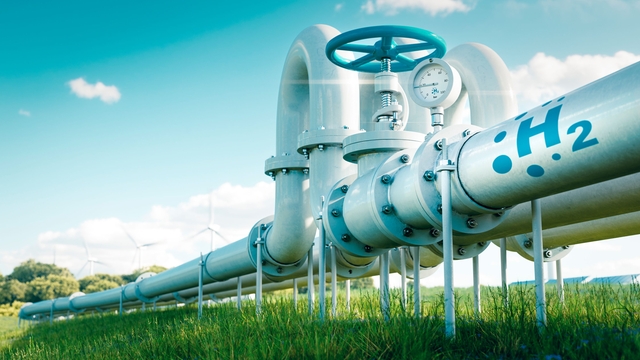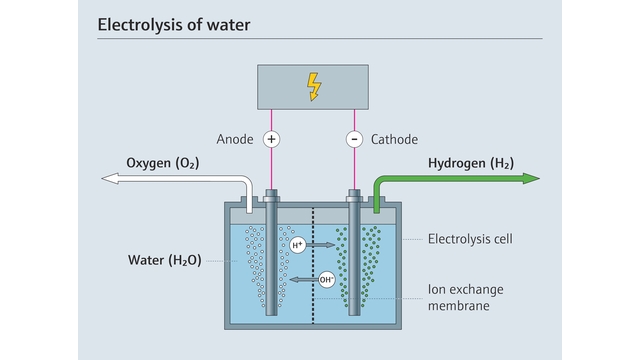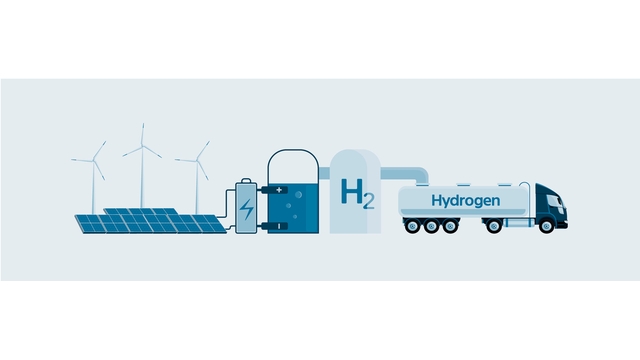Scaling infrastructure to add green hydrogen
While in the initial stages of development, industrialized hydrogen technologies present a significant opportunity for augmenting global energy infrastructure and reducing carbon emissions.

Ve zkratce
- Green hydrogen, produced from renewable energy, is a key tool for achieving net-zero emissions, but widespread adoption faces infrastructure challenges.
- Overcoming these challenges requires investment in research, collaboration across industries and strong governmental support.
- Pipeline infrastructure is limited for handling hydrogen, and leveraging existing natural gas infrastructure has unique challenges. Grey hydrogen is in the greatest abundance among hydrogen produced, but its production emits greenhouse gases. Green hydrogen production through electrolysis is therefore preferred, but its viability requires scaling up electrolyzer capacity and efficiency, transportation and storage infrastructure and affordable renewable energy sources.
- Green hydrogen provides advantages, like long-term energy storage and the ability to generate additional electricity during peak demand, pairing it nicely with smart grid management systems. It can also power vehicles and industrial processes.
- Hydrogen’s volumetric energy density is low compared to fossil fuels, but it is much higher than batteries’. Additionally, its mass energy density is higher than that of fossil fuels. These combined advantages make hydrogen an attractive fuel for long haul trucking, aviation and aerospace where payload must be maximized.
- Governments around the world are implementing policies to accelerate green hydrogen adoption, including funding research, offering production incentives and mandating its use in certain applications.
Framework for the green hydrogen market
The global push for greenhouse gas reductions has propelled hydrogen - specifically green hydrogen produced from renewable energy sources - into the spotlight. While still in its infancy, the hydrogen economy presents an opportunity for more sustainable transportation, industrial processes and energy production. However, realizing these benefits requires overcoming several infrastructure challenges downstream of its production.
Widespread adoption of green hydrogen will require continued investment in research and development, cross-organizational collaboration regarding production and consumption and robust policy frameworks.
Safety challenges
First, existing natural gas infrastructure - including pipelines, storage facilities and transportation networks - must be reworked or replaced to handle hydrogen safely and effectively because of its unique chemical properties. Hydrogen gas molecules are the smallest of any type, rendering them prone to leakage. This necessitates the use of specialized materials and sealing techniques to ensure safe and efficient transportation and storage. Furthermore, hydrogen can weaken materially-incompatible pipeline and vessel structures and the nearly invisible flame upon ignition makes it nearly impossible to spot in the daylight, posing safety risks.
 ©shutterstock
©shutterstock
Storage and transportation presents additional logistical complexities. When space is at a premium, either in storage or onboard a vessel for transport, hydrogen's low volumetric energy density compared to natural gas and liquid fossil fuels necessitates extreme conditions - either compression at up to 700 bar (10,500 psi), or liquefaction at temperatures at or below -253° C (-423.4° F). Holding hydrogen in either state is energy-intensive, adding further equipment, energy and cost requirements to long-term storage and transportation.
Addressing the pipeline challenges requires investing in specialized materials resistant to hydrogen embrittlement, while the storage and transportation conundrum compels complicated energy efficiency calculations and decision-making based on numerous variables.
Production requirements and societal factors
Currently, most hydrogen production relies on extraction from fossil fuels through processes such as steam methane and autothermal reforming. In their simplest forms, these processes produce grey hydrogen, so called because it includes carbon dioxide and other greenhouse gases that undermine the environmental benefits sought from hydrogen. This offgas can be captured - yielding blue hydrogen - but capturing, transporting and storing it is costly.
Green hydrogen production eliminates these issues, but it introduces the need for substantial investments in electrolyzers - typically proton exchange membrane or alkaline type - capacity, grid infrastructure and other ecosystem investments in the balance of the plant. Electrolysis uses electricity to split water molecules into their constituent hydrogen and oxygen components, with the hydrogen harvested and the harmless oxygen gas released to atmosphere or further processed for other industrial uses. When powered by renewable energy sources - such as wind, solar or hydroelectric - the resulting hydrogen is green and sustainable.
 ©Endress+Hauser
©Endress+Hauser
Powering the grid with electricity produced from green hydrogen poses some challenges as it requires new energy infrastructure and seamless integration into existing power systems. This integration is becoming increasingly necessary. Populations are turning to smart grids, energy storage solutions and sophisticated energy management systems to balance the growing demand for renewable energy as demands fluctuate in and out of alignment with intermittent supply.
Though hydrogen lags behind traditional fossil fuels in terms of cost per energy unit, its price is expected to decrease in the coming decades. This can be attributed to the evolution of production and usage technologies, public and private infrastructure investments coming to fruition and widespread standardization of safety practices.
Green hydrogen market appeal
Despite these challenges, the green hydrogen economy is compelling because of its net-zero potential. Paired with clean production practices, water vapor can be renewable hydrogen’s only emission, establishing the gas as a crucial component for achieving emissions targets and mitigating climate change.
Insights
Paired with clean production practices, water vapor is renewable hydrogen’s only emission when used in fuell cells, establishing the gas as a crucial component for achieving emissions targets and mitigating climate change.
Moreover, hydrogen can be stored in various forms for extended periods without the energy degradation drawbacks of batteries - at the expense of lower electricity generation efficiency in short-term storage - addressing intermittency issues of direct renewable solar and wind power sources. This stored hydrogen can then be utilized to generate electricity during periods of peak demand, enhancing grid stability and reliability, or to power vehicles or industrial processes. The ability to flexibly store and dispatch renewable energy is a key component for successfully operating renewably-sourced power grids.
 ©Endress+Hauser
©Endress+Hauser
In addition to generating electricity, hydrogen has a wide array of other uses, from powering heavy-duty vehicles and industrial processes, to heating homes and other buildings. In the transportation sector, hydrogen fuel cell vehicles offer a zero-emission alternative to diesel trucks and buses, providing greater range and faster refueling times compared to battery-equipped electric vehicles. Particularly for long-haul trucking, battery weight and long charging times pose logistical and economic barriers.
 ©Adobe Stock/scharfsinn86
©Adobe Stock/scharfsinn86
In industry, hydrogen can be used as a clean feedstock for producing ammonia and other chemicals, reducing reliance on fossil fuel-based processes in sectors like steelmaking, cement manufacturing and fertilizer production.
Government support
Governments around the world are recognizing hydrogen’s transformative potential and as a result, they are implementing policies and incentives to accelerate its adoption. Examples include direct funding for research and development, tax credits for hydrogen production and use, and mandates for blending hydrogen into existing natural gas networks where possible as a transitional measure.
Insights
Governments globally are implementing policies and incentives to accelerate the green hydrogen economy via direct funding for research and development and tax credits for hydrogen production and utilization.
For instance, the European Union unveiled its Hydrogen Strategy , which aims to establish a complete hydrogen value chain, including a plan to install 40 gigawatts of electrolyzer capacity by 2030. Meanwhile, Japan and South Korea each announced ambitious plans to become hydrogen-powered societies . International collaborations are also emerging to harmonize standards and regulations, facilitating cross-border hydrogen trade.
Timeline for scaling and global hydrogen demand
While the timeline to fully realize the hydrogen economy remains uncertain, most experts predict significant growth throughout the coming decades. The Hydrogen Council, a global CEO-led initiative, projects that hydrogen could meet up to 24% of global energy demand by 2050 , with the market reaching $2.5 trillion annually. This growth must be driven by a confluence of factors, including technological advancements in hydrogen production and storage, declining renewable energy costs and increasingly strict governmental climate policies.
The green hydrogen economy’s viability also relies on the availability of renewable energy sources and the development of efficient infrastructure. While green hydrogen production is largely supported by governmental incentives currently, costs are projected to decline as technology improves, economies of scale are achieved and global demand for hydrogen increases. The US government, for instance, is targeting costs of $2 USD/kg by 2026 and $1 USD/kg by 2031 .
Similar to the way batteries and solar panels advanced over the previous two decades, hydrogen energy technologies present a largely-untapped opportunity for efficiencies and growth in the near-term. As production costs decrease and infrastructure expands, hydrogen is expected to gradually penetrate other sectors, ultimately reducing energy system carbon emissions.
Economics of green hydrogen rely on collaboration and cooperation
Successfully scaling the hydrogen energy market is dependent on collaboration among research institutions, governments and industry stakeholders. Clear and consistent policy frameworks that provide long-term certainty are essential to attract investment and foster low-carbon innovation, while international cooperation is crucial to establish global standards and regulations, facilitating the cross-border hydrogen trade.
In addition to incentivized and sustained research and development efforts, overcoming technical barriers - such as improving the efficiency and reducing the cost of electrolyzers, devising more energy-efficient hydrogen pressurization and liquefaction technologies and developing sufficient pipelines - will be necessary for widespread hydrogen adoption alongside existing fossil fuels.
Finally, continued standards, policies and education regarding safe hydrogen production, storage and handling will help build essential public trust and foster a positive perception of the fuel’s clean energy potential. While significant adoption challenges remain, the hydrogen economy outlook is bright. By addressing infrastructure limitations, fostering technological advancements and implementing supportive policy frameworks, green hydrogen can play a pivotal role in reducing carbon emissions in the decades ahead.



